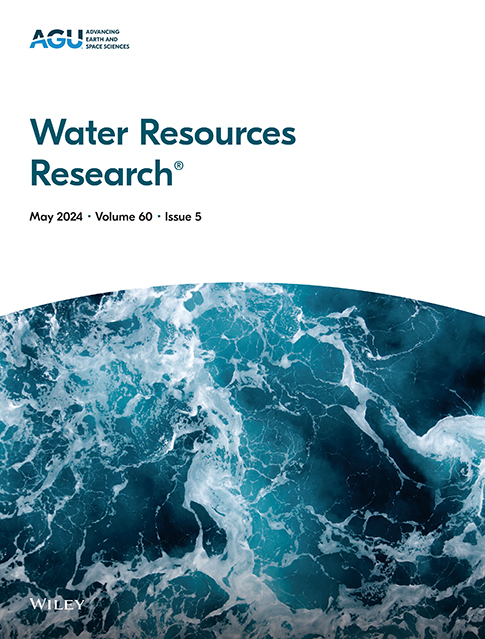Flow Resistance and Hydraulic Geometry in Gravel-And Boulder-Bed Rivers
IF 5
1区 地球科学
Q2 ENVIRONMENTAL SCIENCES
引用次数: 0
Abstract
The frictional resistance of river beds affects how water discharge is partitioned between depth and velocity, which is important in many aspects of hydrology, geomorphology, and aquatic ecology. Many of the most widely-used resistance equations predict reach-average velocity from relative submergence (RS), the ratio of mean flow depth to a bed roughness height such as the 84th percentile of the bed grain-size distribution (D84). Nondimensional hydraulic geometry (HG) is an alternative approach that directly partitions unit discharge into depth and velocity. We show that any RS equation has an implicit or explicit HG equivalent, and the other way round. Analysis of a large set of flow measurements in gravel- and boulder-bed channels confirms previous findings that HG equations using D84 outperform mathematically equivalent RS equations in predicting velocity. This paradox is explained by mathematical analysis and numerical experiments, both of which show that HG equations are less sensitive to the inevitable measurement uncertainty in the variables required for a prediction and the observed velocity used for testing. We also propose a new, simple and effective HG equation using D84 to predict depth and velocity from unit discharge. It is derived in the same way as the now widely-used variable-power equation equation (Ferguson, 2007, https://doi.org/10.1029/2006wr005422) and for deep flows it reduces to an inverted Manning-type equation. It should be possible to use HG equations for flow resistance in sand-bed and bedrock rivers, but this may require new definitions of roughness height.砾石-卵石河床的水流阻力与水力几何
河床的摩擦阻力影响着水流在深度和流速之间的分配,这在水文学、地貌学和水生生态学的许多方面都具有重要意义。许多最广泛使用的阻力方程通过相对淹没(RS)、平均流动深度与床层粗糙度高度的比值(如床层粒度分布的第84个百分位)来预测达到平均速度。无量纲水力几何(HG)是一种替代方法,它直接将单元流量划分为深度和速度。我们证明任何RS方程都有一个隐式或显式的HG等价,反之亦然。对砾石和砾床通道中大量流动测量的分析证实了之前的发现,即使用D84的HG方程在预测流速方面优于数学上等效的RS方程。数学分析和数值实验解释了这一悖论,两者都表明HG方程对预测所需变量的不可避免的测量不确定性和用于测试的观测速度不太敏感。我们还利用D84提出了一个新的、简单有效的HG方程来预测单位流量的深度和速度。它与现在广泛使用的变功率方程方程(Ferguson, 2007, https://doi.org/10.1029/2006wr005422)的推导方式相同,对于深层流动,它可以简化为倒曼宁型方程。在砂床和基岩河流中,应该可以使用HG方程来计算流动阻力,但这可能需要对粗糙度高度进行新的定义。
本文章由计算机程序翻译,如有差异,请以英文原文为准。
求助全文
约1分钟内获得全文
求助全文
来源期刊

Water Resources Research
环境科学-湖沼学
CiteScore
8.80
自引率
13.00%
发文量
599
审稿时长
3.5 months
期刊介绍:
Water Resources Research (WRR) is an interdisciplinary journal that focuses on hydrology and water resources. It publishes original research in the natural and social sciences of water. It emphasizes the role of water in the Earth system, including physical, chemical, biological, and ecological processes in water resources research and management, including social, policy, and public health implications. It encompasses observational, experimental, theoretical, analytical, numerical, and data-driven approaches that advance the science of water and its management. Submissions are evaluated for their novelty, accuracy, significance, and broader implications of the findings.
 求助内容:
求助内容: 应助结果提醒方式:
应助结果提醒方式:


